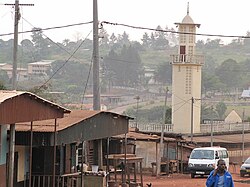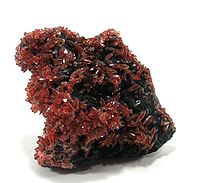Moanda
Moanda
Abu Bakry Sidik | |
|---|---|
 | |
|
Lemboumbi-Leyou Department | |
| Population (2010) | |
| • Total | 39,298 |
Moanda is one of the largest towns in
History
Moanda was originally a village lying on the
Geography and climate
Moanda lies on several adjacent plateaus lying between the higher and larger Bangombe plateau in the north, and the Miosso swamp in the south. Rocky formations Mount Boundinga and Mount Moanda lie further south.
The climate is equatorial, with an alternation of
| Climate data for Moanda | |||||||||||||
|---|---|---|---|---|---|---|---|---|---|---|---|---|---|
| Month | Jan | Feb | Mar | Apr | May | Jun | Jul | Aug | Sep | Oct | Nov | Dec | Year |
| Mean daily maximum °C (°F) | 28.7 (83.7) |
29.4 (84.9) |
29.9 (85.8) |
29.8 (85.6) |
28.8 (83.8) |
27.1 (80.8) |
26.2 (79.2) |
26.8 (80.2) |
28.0 (82.4) |
28.4 (83.1) |
28.5 (83.3) |
28.1 (82.6) |
28.3 (82.9) |
| Daily mean °C (°F) | 24.5 (76.1) |
24.8 (76.6) |
25.1 (77.2) |
25.1 (77.2) |
24.6 (76.3) |
23.2 (73.8) |
22.4 (72.3) |
22.9 (73.2) |
23.8 (74.8) |
24.1 (75.4) |
24.2 (75.6) |
24.1 (75.4) |
24.1 (75.4) |
| Mean daily minimum °C (°F) | 20.2 (68.4) |
20.1 (68.2) |
20.2 (68.4) |
20.4 (68.7) |
20.3 (68.5) |
19.3 (66.7) |
18.5 (65.3) |
18.9 (66.0) |
19.6 (67.3) |
19.8 (67.6) |
19.8 (67.6) |
20.0 (68.0) |
19.8 (67.6) |
| Average precipitation mm (inches) | 165.3 (6.51) |
202.6 (7.98) |
273.6 (10.77) |
220.5 (8.68) |
213.0 (8.39) |
39.2 (1.54) |
13.5 (0.53) |
19.4 (0.76) |
126.4 (4.98) |
265.8 (10.46) |
274.8 (10.82) |
192.1 (7.56) |
2,006.2 (78.98) |
| Average precipitation days | 13.4 | 15.0 | 17.6 | 16.4 | 15.6 | 3.9 | 2.8 | 3.9 | 11.4 | 18.8 | 20.2 | 16.2 | 155.2 |
| Average relative humidity (%)
|
74 | 84 | 84 | 84 | 84 | 81 | 81 | 81 | 84 | 87 | 87 | 86 | 83 |
| Source: NOAA[5] | |||||||||||||
Divisions
Moanda is divided into three areas. The first area is built on the main plateau and its slopes and includes the commercial centre and populous districts Ankoula, Montagne Sainte and Fumier. The second area includes the most populous districts Alliance, Rio and L'Oasis. The third area is on the easternmost plateau and includes Lekolo and Leyima. Another plateau is home to Rigobert Landji High School, the largest high school in the city. Other districts include the Third Zone in the southwest, and the Mukaba District, on the slopes of the Bangombe Plateau.
Economy

On 24 April 1953 a joint corporation was established to mine a deposit estimated at 50 million tons of manganese ore in Gabon owned by the Bureau of Mines of Overseas France (21%), Eastern Tjbangi Mining Company (15%), Société Mokta El Hadid (15%) and the U.S. Steel (49%). A 220 miles (350 km) railway had first to be built to the coast, so full production was not expected until at least 1960.[6] The Compagnie minière de l'Ogooué (Comilog) had initial capital of CFA 150 million. The first ore was shipped from Moanda on 2 October 1962.[7] Moanda is now one of the largest manganese mining centres in the world. The operating company,
Education
This section needs expansion. You can help by adding to it. (May 2015) |
French international schools include:
- Lycée Henri-Sylvoz
- École primaire Comilog[9]
Sport
The main stadium is Stade Henri Sylvoz, the home of AS Mangasport.
Transport
Moanda is served by
See also
- Muanda, Democratic Republic of the Congo
- Railway stations in Gabon
References
- ^ World Gazetteer[dead link]
- ^ ISBN 978-0-86543-521-6. Retrieved 8 May 2011.
- ^ United States. Joint Publications Research Service (1977). Translations on Sub-Saharan Africa. Retrieved 8 May 2011.
- ^ Economist Intelligence Unit (Great Britain) (1993). Country report: Gabon, Equatorial Guinea. The Unit. p. 1. Retrieved 8 May 2011.
- ^ "Moanda Climate Normals 1961–1990". National Oceanic and Atmospheric Administration. Retrieved 8 March 2015.
- JSTOR 41377627
- ^ Gros, Philippe (August 2008), "La COMILOG, une "success story"" (PDF), Réalités Industrielles (in French): 15, retrieved 15 August 2017
- ^ "Presentation of Eramet manganese activities". Archived from the original on 25 February 2012. Retrieved 6 July 2009.
- ^ "Accueil Archived 4 March 2016 at the Wayback Machine" (Archive). École primaire Comilog. Retrieved on 3 May 2015.
